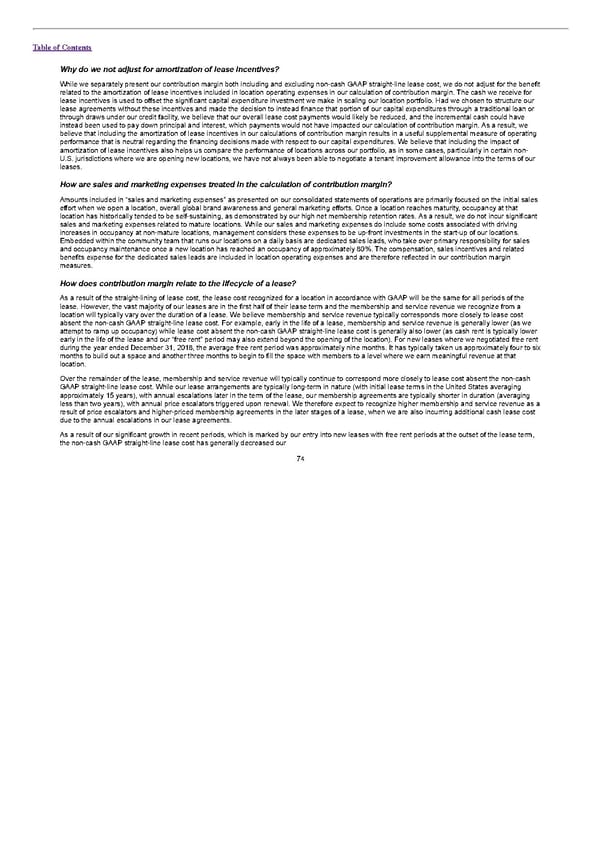Table of Contents Why do we not adjust for amortization of lease incentives? While we separately present our contribution margin both including and excluding non-cash GAAP straight-line lease cost, we do not adjust for the benefit related to the amortization of lease incentives included in location operating expenses in our calculation of contribution margin. The cash we receive for lease incentives is used to offset the significant capital expenditure investment we make in scaling our location portfolio. Had we chosen to structure our lease agreements without these incentives and made the decision to instead finance that portion of our capital expenditures through a traditional loan or through draws under our credit facility, we believe that our overall lease cost payments would likely be reduced, and the incremental cash could have instead been used to pay down principal and interest, which payments would not have impacted our calculation of contribution margin. As a result, we believe that including the amortization of lease incentives in our calculations of contribution margin results in a useful supplemental measure of operating performance that is neutral regarding the financing decisions made with respect to our capital expenditures. We believe that including the impact of amortization of lease incentives also helps us compare the performance of locations across our portfolio, as in some cases, particularly in certain non- U.S. jurisdictions where we are opening new locations, we have not always been able to negotiate a tenant improvement allowance into the terms of our leases. How are sales and marketing expenses treated in the calculation of contribution margin? Amounts included in “sales and marketing expenses” as presented on our consolidated statements of operations are primarily focused on the initial sales effort when we open a location, overall global brand awareness and general marketing efforts. Once a location reaches maturity, occupancy at that location has historically tended to be self-sustaining, as demonstrated by our high net membership retention rates. As a result, we do not incur significant sales and marketing expenses related to mature locations. While our sales and marketing expenses do include some costs associated with driving increases in occupancy at non-mature locations, management considers these expenses to be up-front investments in the start-up of our locations. Embedded within the community team that runs our locations on a daily basis are dedicated sales leads, who take over primary responsibility for sales and occupancy maintenance once a new location has reached an occupancy of approximately 80%. The compensation, sales incentives and related benefits expense for the dedicated sales leads are included in location operating expenses and are therefore reflected in our contribution margin measures. How does contribution margin relate to the lifecycle of a lease? As a result of the straight-lining of lease cost, the lease cost recognized for a location in accordance with GAAP will be the same for all periods of the lease. However, the vast majority of our leases are in the first half of their lease term and the membership and service revenue we recognize from a location will typically vary over the duration of a lease. We believe membership and service revenue typically corresponds more closely to lease cost absent the non-cash GAAP straight-line lease cost. For example, early in the life of a lease, membership and service revenue is generally lower (as we attempt to ramp up occupancy) while lease cost absent the non-cash GAAP straight-line lease cost is generally also lower (as cash rent is typically lower early in the life of the lease and our “free rent” period may also extend beyond the opening of the location). For new leases where we negotiated free rent during the year ended December 31, 2018, the average free rent period was approximately nine months. It has typically taken us approximately four to six months to build out a space and another three months to begin to fill the space with members to a level where we earn meaningful revenue at that location. Over the remainder of the lease, membership and service revenue will typically continue to correspond more closely to lease cost absent the non-cash GAAP straight-line lease cost. While our lease arrangements are typically long-term in nature (with initial lease terms in the United States averaging approximately 15 years), with annual escalations later in the term of the lease, our membership agreements are typically shorter in duration (averaging less than two years), with annual price escalators triggered upon renewal. We therefore expect to recognize higher membership and service revenue as a result of price escalators and higher-priced membership agreements in the later stages of a lease, when we are also incurring additional cash lease cost due to the annual escalations in our lease agreements. As a result of our significant growth in recent periods, which is marked by our entry into new leases with free rent periods at the outset of the lease term, the non-cash GAAP straight-line lease cost has generally decreased our 74
 S1 - WeWork Prospectus Page 78 Page 80
S1 - WeWork Prospectus Page 78 Page 80